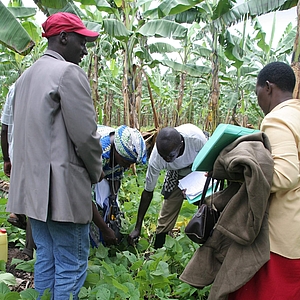A global online survey of banana experts was conducted through ProMusa and the regional banana networks from January to March 2013 to identify key constraints to banana production and marketing for the main banana production systems in different regions. The preparation of the survey included the following components:
- Compilation of a global list of banana experts through the country representatives of the regional banana networks
- Personalized email invitations to the identified experts to participate in the online survey (communication and survey in English, French or Spanish based on the country of origin)
- Posted open online link to the survey on the RTB and ProMusa websites and widely announced online expert survey through social-media and other communication channels
- Developed and tested structured questionnaire with three key sections to elicit expert perceptions
- Open-ended question on major constraints to banana production and marketing;
- Lists of different factors impacting banana yield and income of small-scale banana producers, respectively, which participants weighted
- Scoring exercise for a list of 77 banana research lines to indicate level of importance
A total of 523 banana experts, including scientists, extension staff, producers, and representatives of the private sector, donor organizations and NGOs from more than 54 countries contributed to the survey. The major results are presented in the table below. For more information, please consult the global online expert survey report.
| Major constraints to banana production and marketing | Major constraints to banana yield |
Major income increasing factors for banana production | Most important banana research lines |
|---|---|---|---|
| Based on open-ended question | Based on weighting exercise | Based on weighting exercise | Based on scoring exercise |
|
|
|
|
| Across the sample the responses tend to be at very different levels of specificity. The major purpose of including such an open‐ended question in the questionnaire was(1) to give the respondents the chance to first “speak from their heart” (i.e., be able to voice the concern most pressing to them) and(2) to confirm that no major constraint has been left out in the lists used in the structured subsequent questions. |
Results vary across cultivar groups and regions. For example, for Southern Africa Banana Bunchy Top Virus was the most important yield constraint, while Xanthomonas wilt was reported as major yield constraint for EAHB and Eastern Africa | Little variation across regions and/or cultivar groups in the assessment of importance of different income-determining factors | Results vary across cultivar groups and regions. For instance, respondents from Asia and the Pacific gave highest importance to the breeding for resistance to Fusarium, which globally only received rank 12 |




